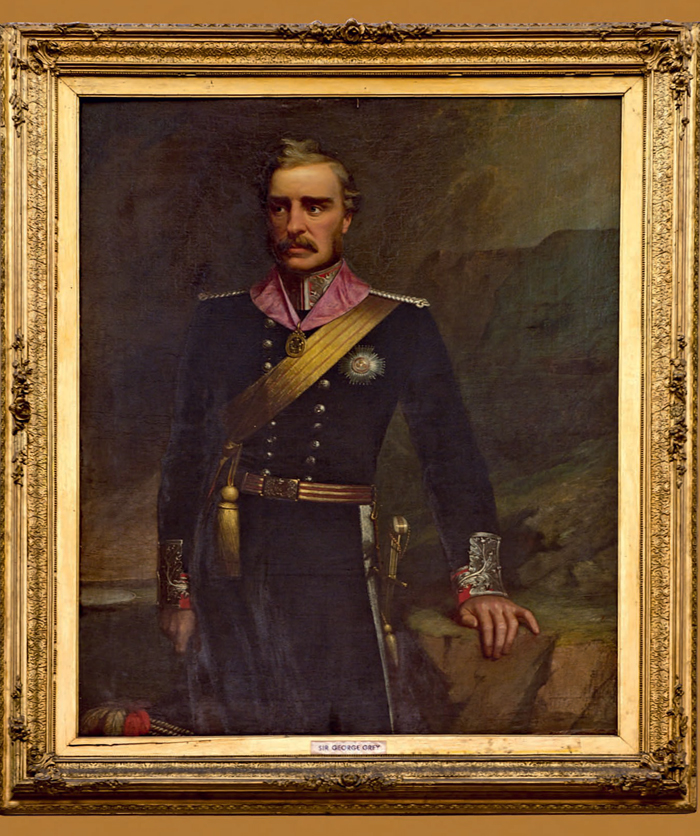NATIONAL LIBRARY OF SOUTH AFRICA
Queen Victoria Street

Portrait of HRH Prince Alfred, Queen Victoria’s favourite son, presented to the library on its opening in 1861 and signed by the artist, Frederick Say (b.1804). During his working life (1830–1860), Say was a fairly prominent society portrait painter, counting the Royal Family as his most high profile clients. After his death, in 1868, he seems to have been largely forgotten. This was one of his last major commissions; painted in commemoration of Alfred’s visit to the Colony to inaugurate new harbour works in Table Bay.
George Basevi’s Fitzwilliam Museum in Cambridge was the model for the design of what is today known as the National Library of South Africa, one of the most important buildings to have been erected in Cape Town in the middle of the 19th century. Greek Revival in style, its Corinthian portico preceded by a shallow flight of stairs, the building was designed by William Kohler (born c.1815) and opened in 1860, at a ceremony conducted by Prince Alfred, Queen Victoria’s favourite son, whose portrait still dominates the main Reading Room.
A public library had originally been established by Government proclamation in 1818. It was managed by a committee that was empowered to raise funds by imposing a tax on every cask of wine passing through the Cape Town market. This tax was removed in 1828, and the library existed thanks to the largesse of local subscribers until 1862, when a government grant was made available.
Inside, it’s hardly changed to this day. Take the computers, the posters and the bad office furniture out of the Reading Room and you have the establishment to which, in 1861, Sir George Grey, ‘one the Cape’s most urbane and enlightened governors’, says Desiree Picton-Seymour, donated his private collection of about 5 000 books and manuscripts – thus forming the core of the new South African Public Library. There are medieval and Renaissance manuscripts and the collection contains, among other items, several humanistic manuscripts whose textual content is rare or unique. Caesar, Livy and Lucan, Boethius and Gregory the Great, Dante and Petrarch are all represented here, as well as several Books of Hours in Latin, French and Dutch. The earliest manuscript is a Latin Bible dating from the ninth century (c.875–900).
In addition to the Grey Collection, the National Library houses extraordinary collections of books, manuscripts, maps, photographs and works of art. The Africana Collection, in particular, is rich in older publications and includes records of the earliest sightings of the Cape by European voyagers, a collection of 18th- and 19th-century accounts of inland exploration (by, for example, Burchell, Le Vaillant, Livingstone, Sparrman and Thunberg), and books describing fauna and flora, dating from the 17th century to the present. The WHI Bleek Collection is, significantly, the first formal, in-depth study of any of the Southern African San languages. The library also houses maps and atlases, and books on every topic from shipping to slavery.
The wing to the right of the entrance portico was completed first. The one on the left, when it was finished, housed the South African Museum, which contained an eclectic array of just about everything you can think of, from birds’ eggs and Ancient Egyptian relics to an embroidered Greek jacket once worn by Lord Byron.

The main Reading Room, dominated by Say’s portrait of HRH Prince Alfred. Its companion piece is a large portrait of Queen Victoria, now in the Houses of Parliament. Kohler, the architect, was described by contemporaries as ‘a draughtsman of great task’ and, while working in the Colonial Engineer’s Department, won the design for what would become the Public Library in an open competition.

The National Library of South Africa houses extraordinary collections of books, manuscripts, maps, photographs and works of art.

A portrait of Sir George Grey in uniform, by Charles Gow, c.1861. The library was constructed at the instigation of Grey, whose collection of books and manuscripts formed the nucleus of its contents – becoming known as the Grey Collection: ‘Being left to some new country, might prove to it a treasure of Great Value, to some extent helping to form the mind of each of its generations, as they come following on,’ wrote Grey.



